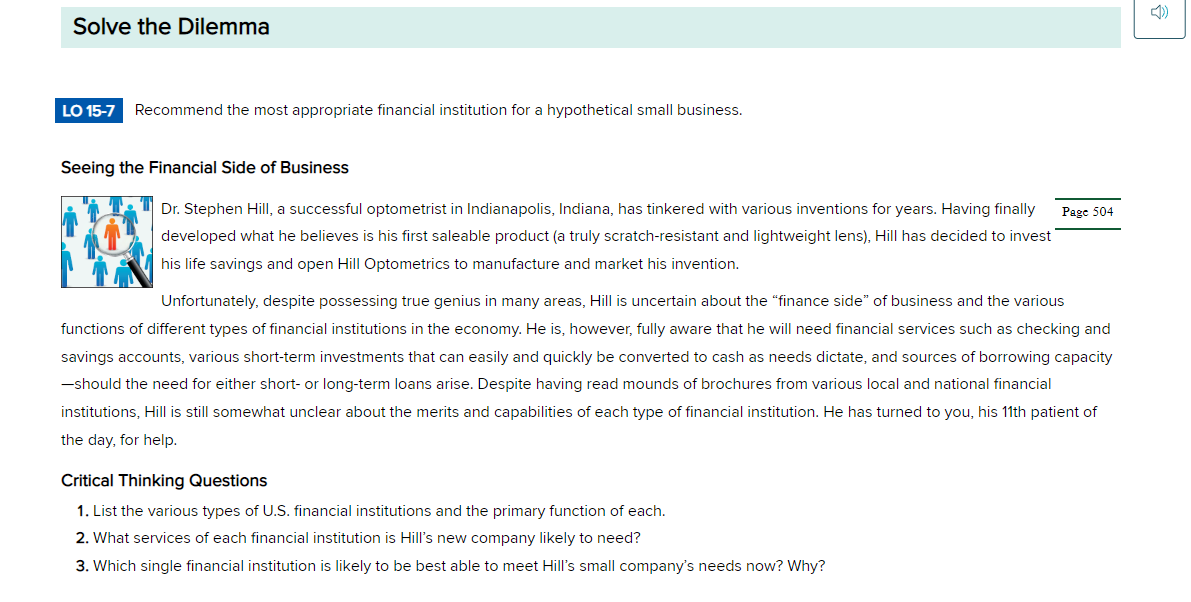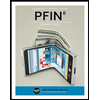Seeing the Financial Side of Business RA Dr. Stephen Hill, a successful optometrist in Indianapolis, Indiana, has tinkered with various inventions for years. Having finally Page 504 developed what he believes is his first saleable product (a truly scratch-resistant and lightweight lens), Hill has decided to invest his life savings and open Hill Optometrics to manufacture and market his invention. Unfortunately, despite possessing true genius in many areas, Hill is uncertain about the "finance side" of business and the various functions of different types of financial institutions in the economy. He is, however, fully aware that he will need financial services such as checking and savings accounts, various short-term investments that can easily and quickly be converted to cash as needs dictate, and sources of borrowing capacity -should the need for either short- or long-term loans arise. Despite having read mounds of brochures from various local and national financial institutions, Hill is still somewhat unclear about the merits and capabilities of each type of financial institution. He has turned to you, his 11th patient of the day, for help. Critical Thinking Questions 1. List the various types of U.S. financial institutions and the primary function of each. 2. What services of each financial institution is Hill's new company likely to need? 3. Which single financial institution is likely to be best able to meet Hill's small company's needs now? Why?
Seeing the Financial Side of Business RA Dr. Stephen Hill, a successful optometrist in Indianapolis, Indiana, has tinkered with various inventions for years. Having finally Page 504 developed what he believes is his first saleable product (a truly scratch-resistant and lightweight lens), Hill has decided to invest his life savings and open Hill Optometrics to manufacture and market his invention. Unfortunately, despite possessing true genius in many areas, Hill is uncertain about the "finance side" of business and the various functions of different types of financial institutions in the economy. He is, however, fully aware that he will need financial services such as checking and savings accounts, various short-term investments that can easily and quickly be converted to cash as needs dictate, and sources of borrowing capacity -should the need for either short- or long-term loans arise. Despite having read mounds of brochures from various local and national financial institutions, Hill is still somewhat unclear about the merits and capabilities of each type of financial institution. He has turned to you, his 11th patient of the day, for help. Critical Thinking Questions 1. List the various types of U.S. financial institutions and the primary function of each. 2. What services of each financial institution is Hill's new company likely to need? 3. Which single financial institution is likely to be best able to meet Hill's small company's needs now? Why?
Chapter2: Career Planning
Section: Chapter Questions
Problem 3FPC
Related questions
Question

Transcribed Image Text:Solve the Dilemma
LO 15-7 Recommend the most appropriate financial institution for a hypothetical small business.
Seeing the Financial Side of Business
Dr. Stephen Hill, a successful optometrist in Indianapolis, Indiana, has tinkered with various inventions for years. Having finally
developed what he believes is his first saleable product (a truly scratch-resistant and lightweight lens), Hill has decided to invest
his life savings and open Hill Optometrics to manufacture and market his invention.
Page 504
Unfortunately, despite possessing true genius in many areas, Hill is uncertain about the "finance side" of business and the various
functions of different types of financial institutions in the economy. He is, however, fully aware that he will need financial services such as checking and
savings accounts, various short-term investments that can easily and quickly be converted to cash as needs dictate, and sources of borrowing capacity
-should the need for either short- or long-term loans arise. Despite having read mounds of brochures from various local and national financial
institutions, Hill is still somewhat unclear about the merits and capabilities of each type of financial institution. He has turned to you, his 11th patient of
the day, for help.
Critical Thinking Questions
1. List the various types of U.S. financial institutions and the primary function of each.
2. What services of each financial institution is Hill's new company likely to need?
3. Which single financial institution is likely to be best able to meet Hill's small company's needs now? Why?
2
Expert Solution
This question has been solved!
Explore an expertly crafted, step-by-step solution for a thorough understanding of key concepts.
This is a popular solution!
Trending now
This is a popular solution!
Step by step
Solved in 4 steps

Knowledge Booster
Learn more about
Need a deep-dive on the concept behind this application? Look no further. Learn more about this topic, finance and related others by exploring similar questions and additional content below.Recommended textbooks for you


Survey of Accounting (Accounting I)
Accounting
ISBN:
9781305961883
Author:
Carl Warren
Publisher:
Cengage Learning

PFIN (with PFIN Online, 1 term (6 months) Printed…
Finance
ISBN:
9781337117005
Author:
Randall Billingsley, Lawrence J. Gitman, Michael D. Joehnk
Publisher:
Cengage Learning


Survey of Accounting (Accounting I)
Accounting
ISBN:
9781305961883
Author:
Carl Warren
Publisher:
Cengage Learning

PFIN (with PFIN Online, 1 term (6 months) Printed…
Finance
ISBN:
9781337117005
Author:
Randall Billingsley, Lawrence J. Gitman, Michael D. Joehnk
Publisher:
Cengage Learning

Pfin (with Mindtap, 1 Term Printed Access Card) (…
Finance
ISBN:
9780357033609
Author:
Randall Billingsley, Lawrence J. Gitman, Michael D. Joehnk
Publisher:
Cengage Learning

Managerial Accounting: The Cornerstone of Busines…
Accounting
ISBN:
9781337115773
Author:
Maryanne M. Mowen, Don R. Hansen, Dan L. Heitger
Publisher:
Cengage Learning